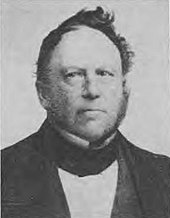Georg Amann (bailiff)
Johann Georg Amann (born April 20, 1794 in Hartwarden ; † September 7, 1852 in Berne ) was a German bailiff in the Grand Duchy of Oldenburg . Due to his strong commitment to the expansion of the local infrastructure, he is considered the father of the Hunte-Ems Canal .
biography
Amann was born as the son of the bailiff Hinrich Jakob Amann (1748–1821) and his wife Dorothea b. Langreuther (1771–1837) was born in Hartwarden. His father initially took over his son's schooling himself. From 1809 to 1811 he attended the upper grades of the grammar school in Oldenburg . However, after the French occupation of Oldenburg , he had to break off school attendance for financial reasons. Apparently his father had lost his job as a result of the French occupation. Instead, Amann took on the post of tax collector for the Abbehausen office . After Duke Peter Friedrich Ludwig von Oldenburg's return, the family's economic situation improved and Amann was able to study law at the University of Göttingen from 1814 to 1816 . After graduation, he entered the Oldenburg state service in March 1817. First he worked as an auditor in Steinfeld and later as a secretary at the Oldenburg Regional Court . In 1821 Amann was transferred to the Oldenburg court chamber and in 1822 assigned to the government of the Grand Duchy.
In September 1827 Amann was then appointed bailiff in Dedesdorf . Right from the start he tried to improve the road network. In May 1833 he was transferred to Berne as a bailiff, where he drove the drainage of the Stedinger Marsch by installing pumping stations . Here, too, he was particularly interested in expanding the traffic routes.
In the 1820s, Amann also advocated the creation of canal connections between Weser and Ems and was able to fall back on preliminary work from the time of the French occupation. In 1826 he presented the project of a Hunte-Ems canal for the first time with an article published anonymously in the "Oldenburgischen Blätter". At first his efforts were unsuccessful. It was not until 1844 that the Oldenburg Shipping Commission in Brake , of which Amann was a member, took up his proposal and proposed the construction of a canal to the Oldenburg government in two reports. The waterway should not only serve as a trade and traffic route, but at the same time allow drainage and thus the development and colonization of the moors of the Grand Duchy. However, the government again rejected these proposals. The combination of the improvement of the infrastructure with the advantages of the solution for the agrarian Oldenburg nevertheless finally ensured the realization of the plan. Amann won over his brother-in-law Johann Ludwig Mosle , who in November 1844 with Amann's drafts gave a much-noticed lecture in the trade and commerce association about the construction of a Hunte-Ems canal, which brought about the decisive breakthrough. The trade and commerce association then had the technical preliminary investigations and route planning carried out. However, Amann did not live to see the start of construction on the canal in 1855.
family
On June 13, 1828, Amann married Adele Charlotte Elisabeth von Jägersfeld (1804–1885), the daughter of the landowner Karl Friedrich von Jägersfeld (1771–1847) and Octavia Bellina nee. Grosse (1772-1815). Her son Wilhelm von Amann (1839–1928) became a Prussian general of the infantry and in 1891 was raised to the hereditary Prussian nobility .
literature
- Hans Friedl: Amann, Johann Georg. Hans Friedl u. a. (Ed.): Biographical manual for the history of the state of Oldenburg . Edited on behalf of the Oldenburg landscape. Isensee, Oldenburg 1992, ISBN 3-89442-135-5 , pp. 32-33 ( PDF; 4.6 MB ).
Individual evidence
| personal data | |
|---|---|
| SURNAME | Amann, Georg |
| ALTERNATIVE NAMES | Amann, Johann Georg |
| BRIEF DESCRIPTION | Bailiff in the Grand Duchy of Oldenburg |
| DATE OF BIRTH | April 20, 1794 |
| PLACE OF BIRTH | Hartwarden |
| DATE OF DEATH | September 7, 1852 |
| Place of death | Berne |
